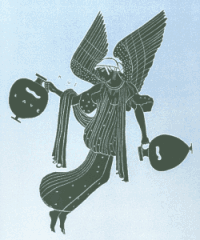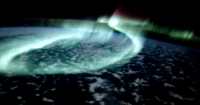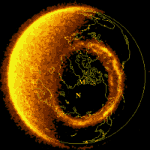Auroras: billboards
for electric space
 |
| |
The Roman goddess
of dawn. |
|
People living in the arctic regions can witness
the aurora - beautiful shimmering curtains
of light appearing in the night sky. Auroras
are like giant advertisements for the existence
of Electric Space; the world's largest neon-like
billboards. They are named after the Roman
goddess of dawn.
Spectacular auroras are phenomena whose
beauty almost defies description. Triggered
by disturbances in the solar
wind and Earth's magnetosphere,
these curtains of light occur when high energy electrons and ions in
the magnetotail are
energized and are guided towards the polar
regions by Earth's magnetic
field. At about 70 miles above the surface,
fast moving electrons encounter Earth's upper
atmosphere, where they slam into gas molecules,
making them glow: oxygen molecules glow whitish-green,
nitrogen molecules glow pink. Contrary to
popular belief, auroras do not produce any
sounds.
 |
| |
A view of the
Southern Lights taken from
the Space Shuttle Discovery
in 1991. Photo courtesy NASA. |
|
NASA's Discovery astronauts
got a great look at the aurora's "curtains" in
1991. This photo of the aurora was taken from
the orbiting space
shuttle several hundred miles above Earth's
South Pole.
Satellites that orbit thousands of miles
above Earth's surface can provide a global
view of the aurora that neither the Space
Shuttle nor ground observations can. These
photographs show that the light of the
aurora forms an oval shape — like a crown
of light
— high above and surrounding Earth's magnetic
poles. The auroral oval or zone expands
and contracts over a period of hours and
days,
depending on geomagnetic activity. The
auroral zone is about six degrees wide, centered
on a magnetic latitude of 67°.

|
| |
A photograph
of the auroral oval taken by
the Dynamics
Explorer - 1 satellite.
Courtesy of Louis Frank, University
of Iowa. |
|
Auroras act as a gauge of what's happening
to Earth's magnetic field tens of thousands
of miles away. On days that are calm, auroras
are only slightly visible, even in the northern
latitudes. But during magnetic storms, the
auroral oval can grow until it can be seen
as far south as Colorado or even Florida.
|

